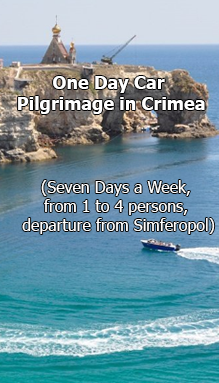The Holy Assumption Monastery near Bakhchisaray
| Status: | active monastery | |
| Sacred objects and relics: | The Bakhchisaray (Mariupol) Icon of the Mother of God | |
The Monastery history
The cave Monastery is situated in the Mairam-Dereh Ravine near Bakhchisaray. The exact date of the Monastery foundation is not known, but, most probably, this is XV c., by the end of which the Assumption Monastery had become the Metropolitan’s residence and the center of the Orthodoxy in Taurida. This place is consecrated by the miraculous appearance of the Icon of the Mother of God, which became the main sacred object of the Monastery and was deeply hallowed not only by the Christians, but also by the Moslems.
Russian tsars supported the Monastery materially, what is confirmed by the diplomas of the Tsars Fedor Ioanovich and Boris Godunov.
From here in 1778 there was the Crimean Christians’ departure to the Azov Region. After the Orthodox Christians’ resettlement from Crimea the Assumption Monastery fell into decay, the Monastery became deserted, the liturgy was occasionally recited.
From the middle of XIX c. there began the restoration of the Christian sacred places. On August 15, 1850 on the feast of the Assumption of the Mother of God there was the inauguration ceremony of the Bakhchisaray Hermitage. At the beginning the monks faced starvation and cold. There were no proper vestments and even candles. However, with the lapse of time they laid out vineyards and orchards, cattle and apiary appeared. They organized the selling of spiritual books, icons, candles, prosphoras. By the beginning of XX c. there had already been five temples already. The ancient cave Church in honor of the Assumption of the Mother of God was considerably expanded. Lower than it there was a small cave Temple in the name of St. Apostle and Evangelist Mark, built on the donations of Simferopol official Aivazov. Below under the rock cope on benefactress E. Berkova’s means there was built the Church in the name of Sts. Equal-to-the-Apostles Tsars Constantine and Helen. On the opposite side of the Ravine St. George the Victorious Temple was erected. The fifth Temple in honor of Innocent of Irkutsk was built in 1896 on the middle area of the Hermitage in commemoration of Archbishop of Kherson and Taurida Innocent (Borisov), who initiated the restoration of this sacred place.
Besides the temples there were built the father superior’s house and two-tier building, in which they placed a refectory, a kitchen with a bakery and six monastic cells. In the rock there were made 16 cells more and two ones were built under the rock. To the top of the monastery plateau there led the stairs consisting of 84 steps, made in the rock. Also they built two two-storied buildings for receiving the pilgrims.
During the Crimean War of 1853–1856 the Monastery gave the hotel for a hospital, where a famous surgeon N. Pirogov used to work. Many participants of the war are buried at the Monastery cemetery. Among them there are Adjutant General P. A. Vrevskiy and Major General P. V. Veimarn, who fell in the Battle of the River Chornaya on August 4, 1855.
In 1921 the Monastery was closed. It was occupied by the colony of invalids, and later its premises were sold or dismantled for building materials.
During the years of the Great Patriotic War in the former Monastery there was also a hospital. 170 heroes of the Crimea delivery found their last shelter at the cemetery at the Monastery Gully.
The Monastery was revived in 1992 with the blessing of His Eminence Lazarus. There have been restored the cave Holy Assumption Church, monastic cells and some utility structures, cave Temple in the name of St. Apostle and Evangelist Mark and the Temple in the name of Sts. Equal-to-the-Apostles Tsars Constantine and Helen, the bell gable has been rebuilt again.
In 1992 under the vaults of the cave temple His Eminence Lazarus held the Divine Liturgy with the consecration of the spring. The life has returned to the Monastery again, it has unrecognizably changed. Despite the fact that around the Assumption Monastery there is still wrangling about returning it its historical territory, a lot of things have been done. Both pilgrims and benefactors have appeared. The transformations, having happened to the Monastery, are wonderful, though for the final revival of the Monastery it is necessary to make still many efforts.












